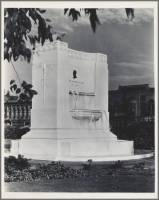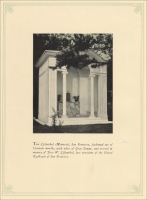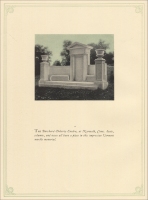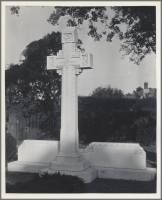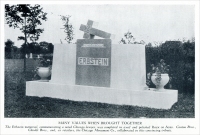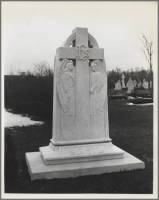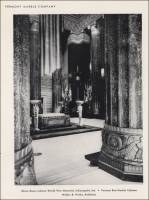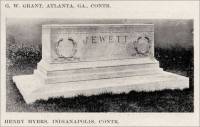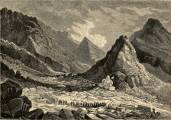
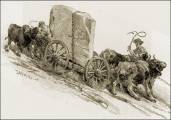

Structures and Monuments
in Which
Vermont Stone was Used
Finished Products from Vermont Stone
- Location of mausoleum is not stated – the Hawley Sarcophagus (From Keeping Up with Marble, by
The Vermont Marble Co., ca. 1913, pg. 40.)
Marble for this monument was purchased from the Vermont Marble Company of Proctor, Vermont. "The Hawley Sarcophagus, built in our Shops for W. P. Pratt, Chatham, N. Y. It now rests within the Mausoleum which was reared in memory of Edwin Hawley, the Railroad Magnate."
- Finished Products from Vermont Stone in Alabama
- Birmingham, Alabama – the Elmwood Cemetery – the Estes Memorial (from “Types of the Year’s Best Cemetery Monuments: Many Distinctive Types: Development of Tablet and Cross Forms” (pdf), from The Monumental News, Vol. XXXIII, No. 1, January 1921, pp. 25.)
“The ‘Estes monument, a simple, two-piece stone, devoid of decoration of any kind, illustrates the art of securing distinctive character solely by the study and line and mass. The perfect proportions and the skilful (sic) treatment of the cap and the grooved line to give the effect of decoration, are markedly successful. This is the work of McDonnell & Sons, of Buffalo, and was designed by John F. Stanley. It stands in Elmwood Cemetery, Birmingham, Ala., and was executed in Barre granite in their Barre Works.”
- Birmingham, Alabama – Elmwood Cemetery – the Scott Memorial (from “Types of the Year’s Best Cemetery Monuments: Many Distinctive Types: Development of Tablet and Cross Forms” (pdf), from The Monumental News, Vol. XXXIII, No. 1, January 1921, pp. 21.)
“Two of the finest of our modern upright tablet forms are seen in the ‘George W. Hill’ and the ‘Scott’ memorials, both the work of McDonnell & Sons, of Buffalo, N.Y., and designed by their chief designer, John Francis Stanley, whose mastery of this type of memorial architecture is well known to readers of Monumental News. The rare grace of line and purity of decoration in these memorials stamp them as classics in their particular class…The Scott stands in Elmwood Cemetery, Birmingham, Ala., and is 5-8x3-0 in ground dimensions, and 8-2 high. The lettering and decoration are executed with the sand blast, and is typical of well studied effects in sand carving. Both of these works are in Barre granite and were executed in the Barre plant of McDonnell & Sons.”
- Gardendale, Alabama – Birmingham
Alabama Temple of the Church of Jesus Christ Latter Day
Saints (photograph and history), presented
on Wikipedia.
Temple of the Church of Jesus Christ Latter Day Saints – The exterior of the Birmingham Alabama Temple is made of white marble from the Danby quarry in Vermont.
- Birmingham, Alabama – the Elmwood Cemetery – the Estes Memorial (from “Types of the Year’s Best Cemetery Monuments: Many Distinctive Types: Development of Tablet and Cross Forms” (pdf), from The Monumental News, Vol. XXXIII, No. 1, January 1921, pp. 25.)
- Finished Products from Vermont Stone in Arkansas
- Little Rock, Arkansas - the Arkansas State Capital
Rotunda, presented on the web
site of the Arkansas Secretary of State. (The information
below was obtained from the “Arkansas
State Capital Virtual Tour.”)
According to the tour, the Rotunda was “The interior (of the rotunda) is constructed of marble from three states. The marble on the floors and walls came from Vermont. The columns around the third floor are Colorado marble, and the grand staircases are Alabama marble.”
- Little Rock, Arkansas - the Arkansas State Capital
Rotunda, presented on the web
site of the Arkansas Secretary of State. (The information
below was obtained from the “Arkansas
State Capital Virtual Tour.”)
- Finished Products from Vermont Stone in California
- Lawndale, California – the Italian Cemetry – the Palmieri Mausoleum (from Vermont Marble Company Dealer’s Sales Portfolio: Information on Designs and Other Illustrations (pdf), October 1940)
- Los Angeles, California – the Flint Memorial Fountain (from Vermont Marble Company Dealer’s Sales Portfolio: Information on Designs and Other Illustrations (pdf), October 1940)
- Palo Alto, California – Stanford Mausoleum on
the Campus of Stanford University (The following information
is from Going Out in Style: The Architecture of
Eternity, by Douglas Keister, Facts On File, Inc., 1997, pp. 5-6. Photographs
of one of the blocks of stone and the completed Stanford Mausoleum are included
in this article.)
Granite quarried in Barre, Vermont, was used in the construction of the Stanford Mausoleum. The mausoleum was completed in 1893.
-
San Francisco, California – the Fletcher-Ryer Exedra (Modern Memorials in Marble, Illustrating designs for various monumental purposes with numerous examples of the use of marble in both ancient and modern times, Vermont Marble Company, Proctor, Vermont, designed, engraved, and printed in Bartlett Orr Press, New York, 1922, pp. 52)
- San Francisco, California - the Hall of Justice
- the Columns and Panels (from Commercial
Marbles of Western Vermont, Bulletin 521, by T. Nelson
Dale, United States Geological Survey, Government Printing
Office, Washington, D. C., 1912.)
Marble from the Barney Marble Company Serpentine Quarry located south of Roxbury Station, Vermont, was used for the Delaware Columns and panels (10 feet 6 inches by 4 feet 2 inches).
- San Francisco, California – the Hancock Memorial (the
canopy) (from The Commercial Granites of New England,
Bulletin 738, 1923.)
Granite quarried from the Barclay Granite Quarry in Barre, Vermont, was used in the construction of the canopy of the Hancock Memorial.
-
San Francisco, California – the Lilienthal Memorial (Modern Memorials in Marble, Illustrating designs for various monumental purposes with numerous examples of the use of marble in both ancient and modern times, Vermont Marble Company, Proctor, Vermont, designed, engraved, and printed in Bartlett Orr Press, New York, 1922, pp. 24)
- San Francisco, San Francisco County, California -
the Spreckels Building on Market Street (Interior) The
following information is from The Monumental News,
August, 1895, Vol. 7, No. 8, Chicago, Illinois, pp. 510.
“San Francisco Notes.
“The marble and granite industry has become quite an important feature of Pacific Coast business and besides the local firms, many of the large eastern concerns are represented by branch establishments carrying considerable stock.
“W. S. Brown & Co., whose works are situated on Mission street, make a specialty of interior decorative work in marble and granite. They executed the vestibule in the new Spreckels building on Market street. The floors are of Italian and the ceiling and wainscoting in Vermont marbles….”
- San Francisco, California -
the St. Regis Hotel -
Marble Fountain, 125 Third Street, San Francisco,
California.
According to a segment of KRON 4 news aired on Wednesday, November 9, 2005, the large pieces of marble used for the fountain was quarried in Vermont.
- Lawndale, California – the Italian Cemetry – the Palmieri Mausoleum (from Vermont Marble Company Dealer’s Sales Portfolio: Information on Designs and Other Illustrations (pdf), October 1940)
- Finished Products from Vermont Stone in Colorado
- Colorado Springs, Colorado – the Evergreen Cemetery – the Wilson Memorial (from Vermont Marble Company Dealer’s Sales Portfolio: Information on Designs and Other Illustrations (pdf), October 1940)
- Colorado Springs, Colorado – the Evergreen Cemetery – the Wilson Memorial (from Vermont Marble Company Dealer’s Sales Portfolio: Information on Designs and Other Illustrations (pdf), October 1940)
- Finished Products from Vermont Stone in Connecticut
- Bridgeport Connecticut – the Bridgeport Trust
Building (from The Commercial Granites of New England,
Bulletin 738, 1923.)
Granite from the Vermont White Quarry located in Woodbury, Washington, Vermont, was used in the construction of the Bridgeport Trust Building.
-
Fairfield, Connecticut – the Oliver C. Jennings Marble Fountain (Modern Memorials in Marble, Illustrating designs for various monumental purposes with numerous examples of the use of marble in both ancient and modern times, Vermont Marble Company, Proctor, Vermont, designed, engraved, and printed in Bartlett Orr Press, New York, 1922, pp. 70)
-
Fairfield, Connecticut – Sunken Garden on an Estate (from “Garden Furniture From Earliest Times, Marble Has Been the Favorite Material for Beautifying Formal Gardens,” in Through the Ages Magazine, July 1926, pp. 25)
- Hartford, Connecticut – the City Hall (from The
Commercial Granites of New England, Bulletin 738, 1923.)
Granite from the Woodbury and Ellis Quarries located at Dummerston, Bethel, Windsor County, Vermont, was used in the construction of the Hartford City Hall.
- Hartford, Connecticut – the State Library (from The
Commercial Granites of New England, Bulletin 738, 1923.)
Granite from the Woodbury and Ellis Quarries located at Dummerston, Bethel, Windsor County, Vermont, was used in the construction of the State Library.
- New Haven, Connecticut - the Connecticut Savings
Bank - the Interior (from Commercial Marbles
of Western Vermont, Bulletin 521, by T. Nelson Dale,
United States Geological Survey, Government Printing Office,
Washington, D. C., 1912.)
White marble from the Eastman Marble Prospect located on the west side of West Rutland, Vermont, was used in the construction of the interior of the Connecticut Savings Bank.
-
Norwalk, Connecticut – the Burchard-Doherty Exedra (Modern Memorials in Marble, Illustrating designs for various monumental purposes with numerous examples of the use of marble in both ancient and modern times, Vermont Marble Company, Proctor, Vermont, designed, engraved, and printed in Bartlett Orr Press, New York, 1922, pp. 44)
- Waterbury, Connecticut – the Clock on the Green The Four Robeson Mountain Quarrie (granite), Woodbury, Washington County, Vermont (From The Commercial Granites of New England, Bulletin 738, 1923.)
- Willimantic, Connecticut – the Hickey Memorial (from “Types of the Year’s Best Cemetery Monuments: Many Distinctive Types: Development of Tablet and Cross Forms” (pdf), from The Monumental News, Vol. XXXIII, No. 1, January 1921, pp. 28.)
“The ‘Hickey’ monument, another example of the massive sarcophagus, shows the virtue of plain, simple contours and good proportions. This is the work of the McGovern Granite Co., of Hartford, Conn., and was cut in their plant at Barre, Vt. It stands in Willimantic, Conn…..”
- Bridgeport Connecticut – the Bridgeport Trust
Building (from The Commercial Granites of New England,
Bulletin 738, 1923.)
- Finished Products from Vermont Stone in Georgia
- Augusta, Georgia – the Boykin-Wright Memorial (from Vermont Marble Company Dealer’s Sales Portfolio: Information on Designs and Other Illustrations (pdf), October 1940)
- Augusta, Georgia – the Jones Memorial (from Vermont Marble Company Dealer’s Sales Portfolio: Information on Designs and Other Illustrations (pdf), October 1940)
- Finished Products from Vermont Stone in Hawaii
-
Honolulu, Hawaii – the Bishop Bank (Advertisement from Through The Ages, Vol. 5, No. 8, December 1927, pp. 45)
Vermont Marble Co., Proctor, Vermont – Branches in the larger cities
See Sweet’s Catalog for Specifications and Other DataWith the Banks in Hawaii: Banking institutions, following trade in its world-wide development, necessarily must be established in many remote geographical localities, but regardless of distance they continue to use marble as a part of their equipment….”
“Hawaii, in mid-ocean, is served by local banks, many having their share of marble. At Honolulu, the Bishop Bank was fitted with Vermont and Tennessee marbles. John Mason, architect.”
-
- Finished Products from Vermont Stone in Idaho
- Boise, Idaho – the State Capitol (the main entrance) (from The
Commercial Granites of New England, Bulletin 738, 1923.)
Stone from the Four Robeson Mountain Quarries (granite),
in Woodbury, Washington County, Vermont, was used in the
construction of the main entrance to the state capitol.
- Boise, Idaho – the
State Capitol (photographs and history)
Most of the external construction material was sandstone from a quarry on Table Rock, east of Boise, which the state purchased for use in building the capitol building. For the interior, four types of marble were used: Reddish-pink marble from Georgia for trim, gray marble from Alaska with inlaid near black Italian marble on the floors and four grand staircases, green swirled marble from Vermont for the walls, and the black marble is from Italy.
- Boise, Idaho – the
State Capitol (photographs and history)
- Boise, Idaho – the State Capitol (the main entrance) (from The
Commercial Granites of New England, Bulletin 738, 1923.)
Stone from the Four Robeson Mountain Quarries (granite),
in Woodbury, Washington County, Vermont, was used in the
construction of the main entrance to the state capitol.
- Finished Products from Vermont Stone in Illinois
- Illinois (?) – the Jewell Memorial (from Monument Trade Builder, January-February, 1918, published by Barclay Brothers, Barre, Vermont, pp. 2)
-
Illinois – the Settlemire Memorial (from Monument Trade Builder, March - April, 1918, published by Barclay Brothers, Barre, Vermont, pp. 5)
- Bloomington, Illinois – the Soldiers and Sailors' Monument. (from The
Commercial Granites of New England, Bulletin 738, 1923.)
Granite quarried from the Four Robeson Mountain quarries located at Woodbury, Washington County, Vermont, was used in the construction of the Soldiers and Sailors' Monument.
- Chicago, Illinois – the American Trust & Savings
Building. (from "Vermont Marble - Part I. Quarries
of the Norcross-West Marble Co., Dorset Vermont," written
by Ernest H. West, from Mine and Quarry Magazine,
Sullivan Machinery Co., Publisher, Chicago, Illinois, March,
1909, pages 271-275.)
Dorset Dark Green Veined marble was used in the interior of the building. The quarry was owned and operated by the Norcross-West Marble Co.
- Chicago, Illinois – the Chicago City Hall "A
Forceful Vermont Industry," from The Vermonter, The State
Magazine, Published monthly by Chas. R. Cummings, White River
Junction, Vermont, January 1911.
The Court House was constructed of Woodbury Gray Granite.
- Chicago, Illinois – the Cook County Courthouse (from The
Commercial Granites of New England, Bulletin 738, 1923.)
Granite quarried from the Four Robeson Mountain quarries located at Woodbury, Washington County, Vermont, was used in the consruction of the Cook County Courthouse.
- Chicago, Illinois - the Chicago City Hall (from “Tools
and Machinery of the Granite Industry,” by Paul Wood,
Part I., Vol. 59, No. 2, June 2006, pp. 42, in The
Chronicle of the Early American Industries Association.)
According to Paul Wood’s article, granite from the Woodbury, Vermont, supplied by the Woodbury Granite Co. of Hardwick Vermont, was used in the construction of the Chicago City Hall.
- Chicago, Illinois – the Englewood National Bank (from
The Commercial Granites of New England, Bulletin 738, 1923.)
Granite quarried from the Fletcher Quarry located at Woodbury, Washington County, Vermont, was used in the construction of the Englewood National Bank.
-
Chicago, Illinois – the Erbstein Memorial (from The Rock of Ages Magazine, November 1927, Rock of Ages Corporation, Barre, Vermont, Vol. V, No. 5, pp. 21)
- Chicago, Illinois - First National Bank (from Commercial
Marbles of Western Vermont, Bulletin 521, by T. Nelson
Dale, United States Geological Survey, Government Printing
Office, Washington, D. C., 1912.)
Marble from the Barney Marble Company Serpentine Quarry located south of Roxbury Station, Vermont, was used in the construction of the First National Bank building.
- Chicago, Illinois - Graceland Cemetery - the Kimball
Monument (from Commercial Marbles of Western
Vermont, Bulletin 521, by T. Nelson Dale, United States
Geological Survey, Government Printing Office, Washington,
D. C., 1912.)
“Second Statuary” marble from the Vermont Marble Company’s West Rutland Quarries Marble Quarry located on the east side of West Rutland, Vermont was used in the construction of the Kimball Monument at Graceland Cemetery in Chicago.
- Chicago, Illinois – the McFadden Building from The
Commercial Granites of New England, Bulletin 738, 1923.)
Granite quarried from the Black Mountain Quarry located at Dumerston, Windham County, Vermont, was used in the construction of the McFadden Building.
- Chicago, Illinois - the Wheeler Residence (from Commercial
Marbles of Western Vermont, Bulletin 521, by T. Nelson
Dale, United States Geological Survey, Government Printing
Office, Washington, D. C., 1912.)
Marble from the New York Marble Quarry located on Dorset Mountain near Dorset, Vermont, was used almost entirely in the construction of the Wheeler residence in Chicago. (The exact location of the residence is not given.)
- Danville, Illinois - the Post Office (from Commercial
Marbles of Western Vermont, Bulletin 521, by T. Nelson
Dale, United States Geological Survey, Government Printing
Office, Washington, D. C., 1912.)
Marble from the Barney Marble Company Serpentine Quarry located south of Roxbury Station, Vermont, was used for the wainscoting in the Post Office in Danville, Illinois.
- Des Plaines, Illinois – the All Saints Cemetery – the Bishop B. J. Sheil Memorial (from Vermont Marble Company Dealer’s Sales Portfolio: Information on Designs and Other Illustrations (pdf), October 1940)
-
Elmwood, Illinois – the Soldiers’ Monument located in the Elmwood city cemetery (from The Monumental News, Vol. XIX, No. 2, February 1907, pp. 150, 152)
“J. P. Bourgoin & Co., of Elmwood, Ill., were the contractors of the soldiers’ monument…erected in the city cemetery of that town by the Woman’s Relief Corps and citizens of Elmwood. It stands about eighteen feet high on a base six feet square and is executed entirely in Woodbury granite with the exception of the die which is of Barre granite. The entire work, with the exception of the statue, was finished at the plant of Bourgoin & Co.….”
- Peoria, Illinois – the Reverend James J. Quinn Monument (Advertisement from Wetmore & Morse Granite Company; Quarries, Barre, Vermont; Main Office, Montpelier, Vermont, The Monumental News, Vol. XLL, No. 8, August, 1929, pp. 371. Quarries at Barre, Vermont; Main Office, Montpelier, Vermont. Webmore & Morse Granite Co. established in 1862.)
- Quincy, Illinois – the Family Tomb of Timothy Rogers.
The information below about the construction of the tomb is
from the back of a stereo view card which was published about
the late 1870s.
The Tomb of Timothy Rogers was built by the Burlington Manufacturing Co. of Vermont, of Marble from marble quarried in North Pittsford, Vermont. The architect was George W. Bunting, Indianapolis, Indiana. (The card does not indicate in what cemetery the tomb is located.)
- Serena, Illinois – the Indian Massacre Memorial (from The
Commercial Granites of New England, Bulletin 738, 1923.)
Granite quarried from the Barclay Quarry located at Barre, Washington County, Vermont, was usedin the construction of the Indian Massacre Memorial.
-
Toulon, Illinois – the Grearson-Beckett Company, Granite Manufacturers (Grearson-Beckett Co., Williamstown, Vt., advertisement from The Monumental News, March 1906, pp. 231)
Grearson-Beckett Company, Granite Manufacturers, Williamstown, Vt.
Large Monumental Work and have every facility for handling it. We are located conveniently to the Barre Quarries. - Urbana-Champaign, Illinois – University of Illinois
The Natural Resources Building (The link from which
the following information was obtained is no longer available.)
<http://www.isgs.uiuc.edu/build/fulltext.html>The slate on the roof of the building "...was quarried from the Maine and western Vermont slate belt by the Rising and Nelson Slate Company of West Pawlett, Vermont...."
- Wheaton, Illinois – the Gary Mausoleum (from The
Commercial Granites of New England, Bulletin 738, 1923.)
Granite quarried from the Jones Light Granite Quarry located at Barre, Washington County, Vermont, was used in the construction of the Gary Mausoleum. The book also states that the roof stones were of the "light," 35 by 9 feet 6 inches by 1 foot 6 inches each.

“Executed in Wetmore & Morse stock by Anderson-Friberg Co., Barre, Vt., for John Merkle & Sons, Peoria, Illinois.”
“Soldiers’ Monument, Toulon, Illinois. Made by Grearson-Beckett Company of Williamstown, Vermont, for H. M. Teets.” (from The Monumental News, March 1906, pp. 231) 
- Finished Products from Vermont Stone in Indiana
- Angola, Indiana – the Soldiers and Sailors' Monument (from The
Commercial Granites of New England, Bulletin 738, 1923.)
Granite from the Jones Light granite quarry located at Barre, Washington County, Vermont, was used in the construction of the Soldiers and Sailors Monument at Angola.
-
Evansville, Indiana – the Lauenstein Monument made for F. J. Scholz & Son (Novelli & Calcagni advertisement from The Monumental News, March 1906, pp. 237)
Novelli & Calcagni, Barre, VT.
We make a specialty of Statuary and fine carved monuments in Barre Granite
A specimen of our work made for F. J. Scholz & Son, Evansville, Indiana - Indianapolis, Indiana - City Hall - the Tiling (from Commercial
Marbles of Western Vermont, Bulletin 521, by T. Nelson
Dale, United States Geological Survey, Government Printing
Office, Washington, D. C., 1912.)
Marble from the Barney Marble Company Serpentine Quarry located south of Roxbury Station, Vermont, was used for the tiling in the Indianapolis City Hall.
- Indianapolis, Indiana – Crown Hill Cemetery – the Rauch Memorial (from Vermont Marble Company Dealer’s Sales Portfolio: Information on Designs and Other Illustrations (pdf), October 1940)
- Indianapolis, Indiana – Crown Hill Cemetery – the Schwitzer Columbarium (from Vermont Marble Company Dealer’s Sales Portfolio: Information on Designs and Other Illustrations (pdf), October 1940)
- Indianapolis, Indiana – the Indiana World War Memorial – the Shrine Room. The photograph below Marble Color Plates: Imported and Domestic Catalog (PDF, 6 MB), Vermont Marble Company, Proctor, Vermont, no date of publication, early- to mid-1900s.
- New Albany, Indiana – the Jewett Memorial (from “Types of the Year’s Best Cemetery Monuments: Many Distinctive Types: Development of Tablet and Cross Forms” (pdf), from The Monumental News, Vol. XXXIII, No. 1, January 1921, pp. 26.)
“The ‘Jewett’ is an interesting form of the massive standard sarcophagus of severe lines, decorated with some unusually fine carving. This work was erected by Henry Myers, of Indianapolis, in New Albany, Ind., and was cut for him in Barre granite by the Valz Granite Co., of Barre, Vt. The dimensions are: Base, 10-0x5-4x1-2; second base, 7-8x3-0x1-0; die, 6-10x2-2x2-2.”
- Rockville, Indiana – the Rockville City Cemetery – the Juliet Virginia Strouse Memorial & another Strouse Memorial (from “Types of the Year’s Best Cemetery Monuments: Many Distinctive Types: Development of Tablet and Cross Forms” (pdf), from The Monumental News, Vol. XXXIII, No. 1, January 1921, pp. 30-31.)
“Another handsome variation of (the modern pyramidal tablet) is illustrated, and was recently erected by Theo. F. Gaebbler, of Rockville, Ind., in the Rockville City Cemetery, to the memory of Mrs. Juliet Virginia Strouse, better known to the women of America as the ‘Country Contributor’, under the name she contributed to the Ladies’ Home Journal…It was cut by the Carswell-Wetmore Co., of Barre, Vt. The material is fine grained Barre granite, all 12-cut…with square raised hammer finished letters.
“Mr. Gaebler has also erected another distinctive tall tablet, the ‘Strouse’ memorial which stands on the family lot of the brother-in-law of the ‘Country Contributor and was cut for Mr. Gaebler by Geo. Straiton, of Barre, Vt…The design is one adapted by Mr. Gaebler, from the ‘Hope’ design by Fred Haslam published in the Monumental News of May, 1916, which showed a polished monument. Mr. Gaebler made of it an all axed job with square raised carving and lettering. He has sold no fewer than eight duplicates of this monument in three years, but has never allowed two monuments of this design to go in the same cemetery.”
“A specimen of our work made for F. J. Scholz & Son, Evansville, Indiana.” (Novelli & Calcagni advertisement from The Monumental News, March 1906, pp. 237) 
- Angola, Indiana – the Soldiers and Sailors' Monument (from The
Commercial Granites of New England, Bulletin 738, 1923.)
Commercial use of material within this site is strictly prohibited. It is not to be captured, reworked, and placed inside another web site ©. All rights reserved. Peggy B. and George (Pat) Perazzo (deceased).



